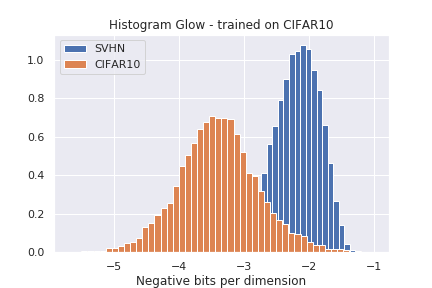This repository implements the Glow model using PyTorch on the CIFAR-10 and SVHN dataset. We use the trained Glow to reproduce some of the results of the paper "Do Deep Generative Models Know What They Don't Know?":
To create histogram: See notebook. Pretrained model (on CIFAR-10): download (unzip before use).
Note this pretrained model was created using the affine coupling layer, so it does not work well for generative sampling (see qualitative vs quantitative models in the Glow paper). The pretrained model achieves 3.39 bpd, while the original paper gets 3.35. The difference between our pretrained model and the paper is that we use batch size 64 (single GPU) and the paper uses 512 (8 GPU).
This code uses some layers and groundwork from glow-pytorch, but is more modular, extendable, faster, easier to read and supports training on CIFAR-10 and SVHN. There are fewer dependencies and a consistent interface for new datasets. Thanks to Milad for comments and help with debugging.
The code has minimal dependencies. You need python 3.6+ and up to date versions of:
pytorch (tested on 1.1.0)
torchvision
pytorch-ignite
tqdm
To install in a local conda:
conda install pytorch torchvision pytorch-ignite tqdm -c pytorch
To train your own model:
python train.py --download
Will download the CIFAR10 dataset for you, and start training. The defaults are tested on a 1080Ti, Glow is a memory hungry model and it might be necessary to tune down the model size for your specific GPU. The output files will be send to output/.
Everything is configurable through command line arguments, see
python train.py --help
for what is possible.
There are two notebooks available for evaluation:
- The first notebook reproduces a plot from "Do Deep Generative models know what they don't know?" (see above) and computes the average bpd on the CIFAR-10 and SVHN test sets.
- The second notebook allows you to visualise samples from the model (This works best with a model trained using the
additivecoupling layer).
There are several possible extensions:
- Multiclass conditional training
- multiGPU
- port over the tests
PRs for any of these would be very welcome. If you find any problem, feel free to make an issue too.
The model is trained using adamax instead of adam as in the original implementation. Using adam leads to a NLL of 3.48 (vs. 3.39 with adamax). Note: when using adam you need to set warmup to 1, otherwise optimisation gets stuck in a poor local minimum. It's unclear why adamax is so important and I'm curious to hear any ideas!
@inproceedings{kingma2018glow,
title={Glow: Generative flow with invertible 1x1 convolutions},
author={Kingma, Durk P and Dhariwal, Prafulla},
booktitle={Advances in Neural Information Processing Systems},
pages={10215--10224},
year={2018}
}
@inproceedings{nalisnick2018do,
title={Do Deep Generative Models Know What They Don't Know? },
author={Eric Nalisnick and Akihiro Matsukawa and Yee Whye Teh and Dilan Gorur and Balaji Lakshminarayanan},
booktitle={International Conference on Learning Representations},
year={2019},
url={https://openreview.net/forum?id=H1xwNhCcYm},
}
